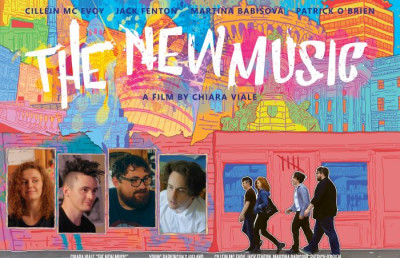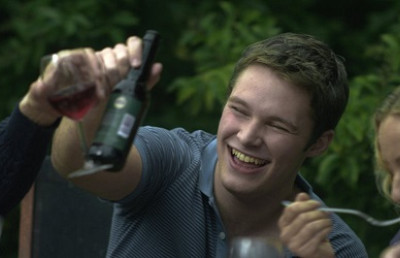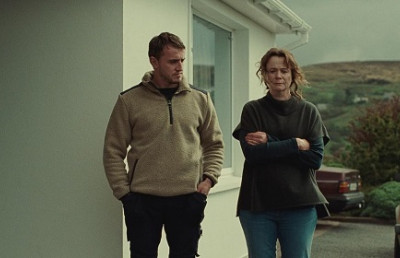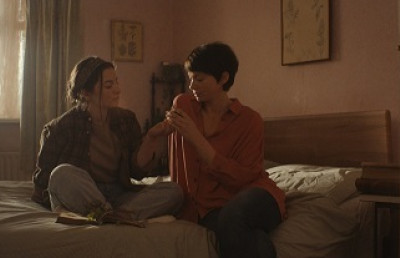Imagining the Irish Revolution on Film
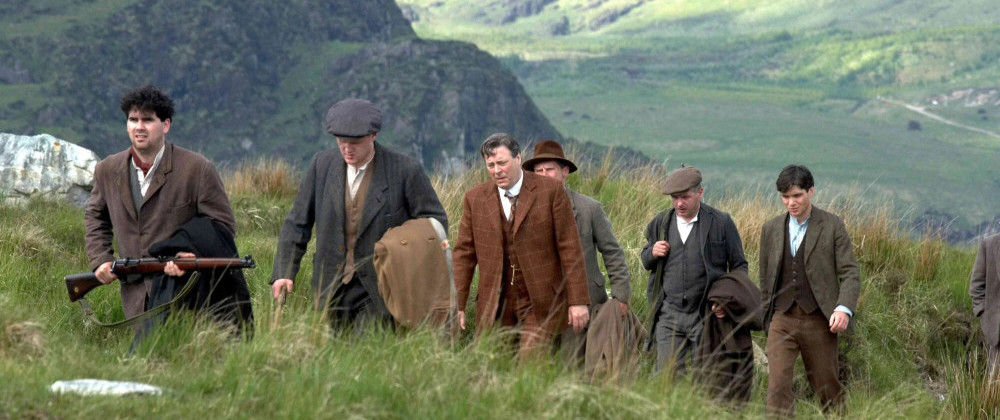
The Wind That Shakes the Barley (Ken Loach, 2006) (Photo source, IFC Films)
If there is one thing that cinematic representations of the crucial period in modern Irish history that runs from 1916 to 1923, encompassing the Easter Rising, the Anglo-Irish War, the creation of the Irish Free State, and the subsequent Civil War, have in common, it is that the wildly varying interpretations reveal at least as much about the views of their directors and the context in which the films were produced as about the events themselves. As James Chandler points out, this is not a phenomenon that began with Neil Jordan or Ken Loach, or even John Ford; as far back as D.W. Griffith and Sergei M. Eisenstein, filmmakers have been fascinated with the possibilities of using portrayals of the past to shape the future. 1 John Ford, an American-born son of Irish immigrants, had a very romantic view of Ireland and saw the Irish rebels as modern versions of the American founding fathers. He used parallels between the Irish and American revolutions to make events in Ireland comprehensible to American audiences, but also to reinforce the legitimacy of Irish Americans to his countrymen who were not Irish Catholic. In adapting Sean O’Casey’s 1926 play The Plough and the Stars and Liam O’Flaherty’s 1925 novel The Informer (in 1936 and 1935, respectively), he made major changes that removed the significant revisionist and critical views of the Irish revolution in both works to conform to his vision. Neil Jordan, an Irish director who has worked internationally, made his 1996 film Michael Collins in the context of the Northern Ireland peace process that had begun in 1994. He used visual references and changes to the historical record to sharpen parallels between the revolutionary period and the Troubles in Northern Ireland, as well as critiquing the socially conservative Ireland in which he grew up. Ken Loach, a British socialist whose films typically deal with the details of working class life, in The Wind That Shakes the Barley (2006) visualizes the period in terms of contemporary global insurgencies and places his emphasis on anti-colonialism, class conflict, and the alleged betrayal of the workers and agrarian poor who fought the revolution by their bourgeois leadership.
The Irish Revolution on Film
While this essay focuses on this quartet of films, these are, of course, not the only films made about these events. However, given the enormous influence this period has had on Ireland’s subsequent history, even up to the present, where both of its major political parties (Fianna Fáil and Fine Gael) trace their origins to the opposite sides in the Civil War, it is surprising how few films about the revolutionary period have been made, and even more surprising how few of them have been made by Irish filmmakers. The earliest example was an Irish production, Irish Destiny (1926, George Dewhurst), made to mark the tenth anniversary of the Easter Rising, while there was a now largely forgotten British adaptation of Liam O’Flaherty’s novel The Informer in 1929. In time for the Rising’s twentieth anniversary, Hollywood produced a romance, Beloved Enemy (1936, H.C. Potter), which was (very) loosely based on the activities of Michael Collins during the struggle against the British, and included a highly fictional love affair between him and a British aristocrat. The same year, The Dawn (1936) was written, produced, and directed by Killarney garage owner Tom Cooper with the help of 250 non-professional actors recruited from the local area, some of them former Irish Republican Army (IRA) veterans. 2 It is notable that these films, with the exception of The Informer, deal with the War of Independence rather than the Civil War. This is also true of the better-known Guests of a Nation (1935, Denis Johnston) and Ourselves Alone (1936). The latter film, directed by Belfast-born Brian Desmond Hurst, was actually a British production, made by British International Pictures, who were also already responsible for the previously mentioned version of The Informer, as well as Juno and the Paycock (1930, Alfred Hitchcock), an adaptation of Sean O’Casey’s play that was set during the Civil War, suggesting that it was a less sensitive topic for non-Irish filmmakers. 3 The mid-1930s was also when John Ford made The Plough and the Stars and The Informer, which dealt with (in his versions) the Rising and the War of Independence. These were the last theatrical films from anywhere to deal with this topic until Ford’s The Rising of the Moon (1957), one of whose trio of stories was also set during the war with the British. This was soon followed by the Hollywood-financed Shake Hands with the Devil (1959, Michael Anderson), which retold the fight for independence as a gangster film, with Irish-American star James Cagney recruited to play a variation on characters he had played in many American movies. This was soon followed by the celebrated Mise Éire (1959, George Morrison), which has been described as providing the official, patriotic version of events from the Easter Rising through to the 1918 election, which led directly to the forming of a secessionist parliament (Dáil Éireann) and the War of Independence. The follow-up, Saoirse? (1961, George Morrison), which covered the war with the British and the ensuing Civil War was more contentious, its relative obscurity often attributed to its treatment of the divisions within the Irish revolutionaries. 4 The 50th anniversary of the Rising saw the critically praised Insurrection (1966, Michael Garvey and Louis Lentin), a docudrama dramatizing the events of Easter 1916, broadcast on RTE, Ireland’s national broadcaster, over eight 30-minute episodes. This was soon followed by possibly the oddest film about the Irish revolution, David Lean's 198-minute (originally previewed at 220 minutes) epic Ryan's Daughter (1970), a Hollywood-financed tale of a romance set in Kerry in the aftermath of the Easter Rising between a shell-shocked British officer (played by Christopher Jones, who displays the emotional range of a zombie, except less expressive) and a local colleen (played by British actress Sarah Miles, who has been better in other films). Despite being insanely long and boring, it holds a certain cachet as having something in it to offend almost everybody, from its rabble of Irish peasants to the has-to-be-seen-to-be-believed turn by John Mills as an intellectually handicapped villager, to the heavy handed attempts at creating parallels with the Troubles (the story's climax involves Miles having her head shaved by the villagers as a punishment for her affair). The film was scorched by critics and was a box office disappointment. This possibly served to discourage further treatments of the subject, at least from Hollywood, although it doesn't really explain the lack of interest from Irish filmmakers. For whatever reason, outside of a handful of shorts, a TV dramatization of Juno and the Paycock (1980, Roger Cheveley), The Dawning (1988, Robert Knights), a well-reviewed British adaptation of Jennifer Johnston’s novel The Old Jest featuring Anthony Hopkins as an IRA operative hiding from the British army during the Anglo-Irish War, and the RTE drama The Treaty (1991, Jonathan Lewis), which, as it concerns the negotiation of the Anglo-Irish treaty that set off the Civil War, is the closest to approaching that touchy subject, are the only films on the topic until Michael Collins was released in 1996. It is worth noting that this period of low activity, from the mid-1960s to mid-1990s, roughly corresponds to the Troubles in Northern Ireland, with Michael Collins itself unlikely to have received Hollywood financing if there had not been a negotiated ceasefire in place. As there were many films during these years about the unrest in Northern Ireland, it is curious, or maybe not so curious, that no filmmaker probed the Republic of Ireland’s own history of guerilla violence and armed insurrection.
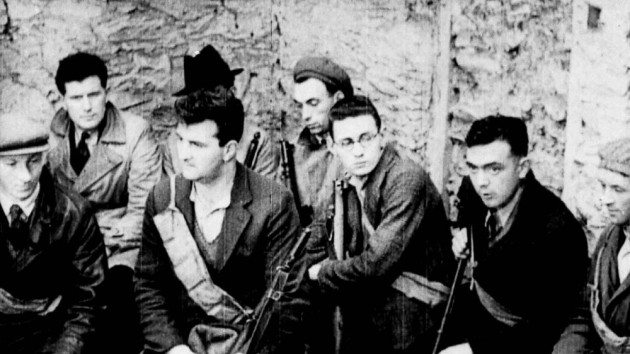
The Dawn (1936, Tom Cooper) (Public domain)
Although the onset of peace in Northern Ireland might have made it easier to approach this topic, this doesn’t seem to have been the case. The box office success of Michael Collins, at least in Ireland, 5 did not lead other filmmakers to take on the revolutionary period. Other than The Last September (1999, Deborah Warner), a France-U.K.-Ireland co-production with a largely English cast that included Michael Gambon, David Tennant, and Maggie Smith, that was similar in many ways to The Dawning (both focus on an Anglo-Irish family during the War of Independence), there were no major films about this era until The Wind That Shakes the Barley, an Ireland-U.K.-Germany-Italy-Spain-France-Switzerland co-production, in 2006. 6 Since then, particularly leading up to the centenary of the Rising, there have been a number of documentaries, shorts, TV films and mini-series dealing with the revolutionary years, but theatrical films on the subject have remained rare. There was A Nightingale Falling (2014, Garret Daly and Martine McGlynn), set during the War of Independence, Aithri (aka Penance, 2018, Tom Collins), which is set during the Troubles in North Ireland, but with flashbacks to 1916, the low budget independent feature Once Upon a Time in Ireland (2021, Conor Slattery), which deals with the Civil War, and The Banshees of Inisherin (2022, Martin McDonagh), which also deals with the Civil War, at least allegorically. However, particularly when compared to the large number of films made about the Troubles, it remains a surprisingly short list.
John Ford’s Imaginary Ireland
In the 1930s, Hollywood filmmaker John Ford made two films about the revolutionary period, in both cases adapting works that sharply insisted that while the British had left, nothing had changed for the broad mass of the Irish people. Sean O’Casey’s play The Plough and the Stars had sparked a riot at its premiere at Dublin’s Abbey Theatre in 1926 with its sourly comic retelling of the by then already mythologized 1916 Easter Rising from the vantage point of the residents of the slum tenements only a few blocks away from the General Post Office, which served as the rebels’ headquarters and main scene of the fighting. 7 In the play, working class men are led by an offstage demagogue (clearly based on rebellion leader Padraig Pearse) into throwing away their lives fighting the “wrong rebellion” as their neighbours die of consumption or take advantage of the confusion to loot the shops. This is a worm’s eye view of history, where the fighting takes place elsewhere and the large historic figures, except for an offstage voice calling for blood sacrifice, absent. Liam O’Flaherty’s novel The Informer is even sharper. Although it is sometimes mistakenly claimed to be set during the Civil War, its events actually take place in 1924, a year after hostilities had formally ended with an IRA ceasefire. The British are gone, but nothing has changed for those at the bottom. As Paula Gilligan writes, the novel’s subject is “the repression of marginal figures who had served their purpose in the revolutionary movements, but whose own needs and desires now posed a threat.” 8 Gypo Nolan’s death symbolizes not only those who had sacrificed for the revolution and were now disposable, but also the fate of Ireland’s poor under their new Free State masters.
Ford’s view of Ireland was very different. When, during the making of the film version of The Plough and the Stars, he was asked by a studio executive why the Irish were fighting the British in the middle of World War I, Ford replied, “the Irish wanted the same thing George Washington sought for his people in the American revolution.” 9 This analogy is clearest in a solemn scene where a Pearse lookalike reads a portion of the Proclamation of the Irish Republic aloud to the other leaders of the Rising and then hands it to a James Connolly 10 lookalike (neither of them are ever named) for signing, the staging reminiscent of portraits of the American founding fathers signing their Declaration of Independence. This not only framed the events sympathetically for an American audience who would have been much more familiar of the details of the American revolution than with events in Ireland, but also had another function. Only eight years before the film’s release, Al Smith, the grandson of Irish immigrants, had become the first Roman Catholic, Irish or otherwise, to be nominated by a major party for President of the United States. In the campaign leading to his landslide defeat, he was subjected to vicious racist abuse targeting his ethnicity and religion. 11 The Plough and the Stars was one of a number of films made in the 1930s and ’40s which featured characters whose Irish heritage was foregrounded, but were also American as apple pie. At a time when the Irish in the United States were considered to be out of the mainstream by many of their fellow citizens, films written or directed (or both) by Irish Americans such as The Irish in Us (1935, Lloyd Bacon), The Great O’Malley (1937, William Dieterle), Little Nellie Kelly (1940, Norman Taurog), The Fighting 69th (1940, William Keighley), Yankee Doodle Dandy (1942, Michael Curtiz), Going My Way (1944, Leo McCarey), and The Sullivans (1944, Lloyd Bacon) crafted a positive, true blue patriotic image. 12 Ford’s version of The Plough and the Stars was a not-too-distant cousin of these films.
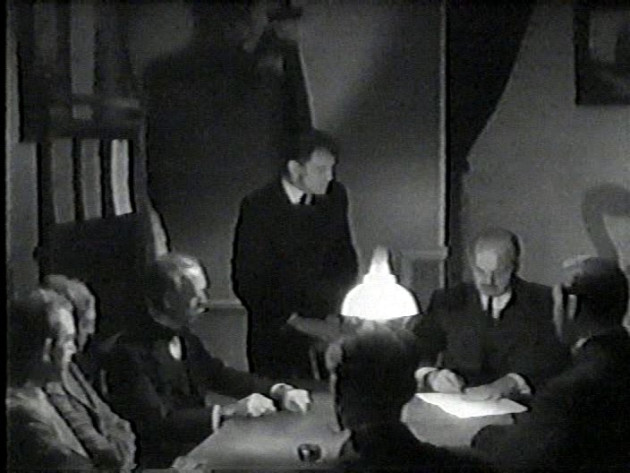
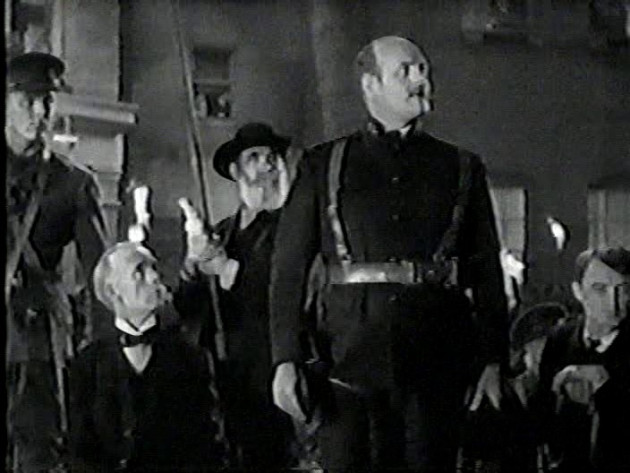
The Plough and the Stars (1936, John Ford): James Connolly signs the Proclamation of the Irish Republic (left) and lookalikes for Thomas Clarke, James Connolly, and Padraig Pearse on a speaker’s platform (right), although none of them are actually named in the film. (Photo source, Network DVD)
This recasting of Pearse and Connolly in the mold of Washington and Jefferson meant that while in the play the rebel leaders were reckless and the fighters tragic victims, Ford treats them as heroes out of legend. A torchlight procession to the accompaniment of “The Rising of the Moon” is filmed in the manner of Triumph of the Will (1935, Leni Riefenstahl), with low angle shots emphasizing the stalwart rebels’ heroic qualities. Connolly, seemingly rendered larger than life by this framing, addresses the meeting, with cutaways to old women in shawls weeping in joy, adoring children, and grim rebels, all of whom cheer wildly when he finishes speaking. This is the history of “great men,” not of the common people. The play’s socialist character The Covey, who claims freedom is meaningless without economic freedom, is reduced to a few lines, and instead Preston Foster as Jack Clitheroe declares on several occasions without a trace of irony that “Ireland is greater than a mother or a wife.” Well might he say so, as he no longer dies as in the play, but lives to make a speech vowing Ireland will fight on until freedom is won.
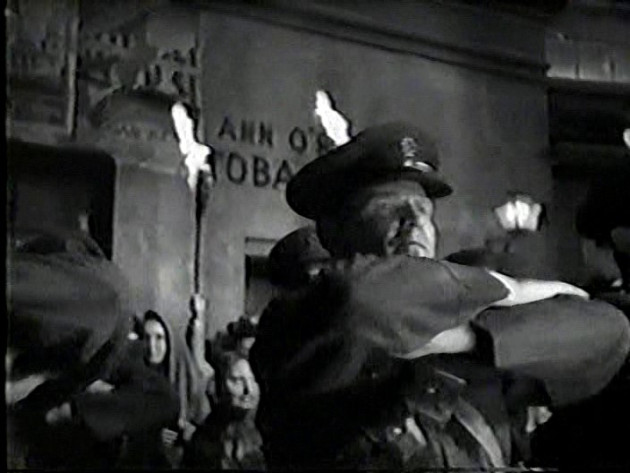
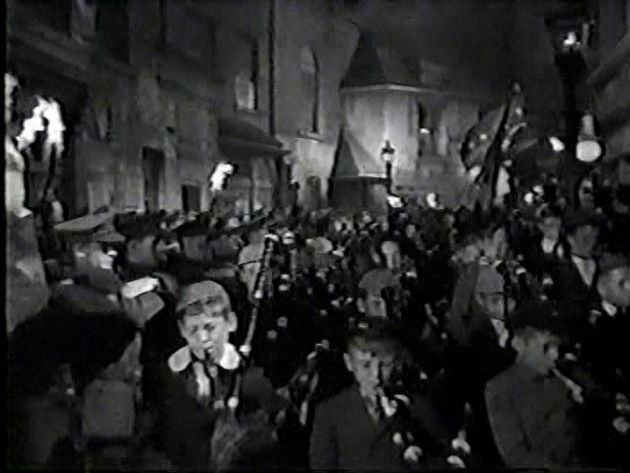
The Plough and the Stars (1936): Stalwart Irish rebel at attention (left) at the torchlight parade (right). (Photo source, Network DVD)

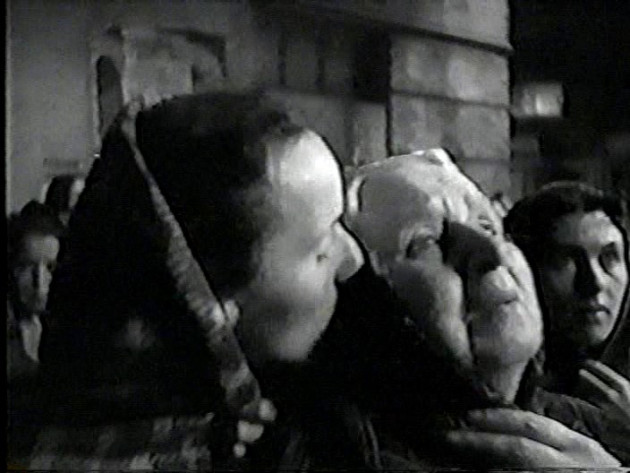
The Plough and the Stars (1936): Connolly (left), looking kind of fascist, addresses crowd. Old woman in shawl (right) weeps in joy. (Photo source, Network DVD)
Also notable in Ford’s reworking of O’Casey’s play is the way the film addresses the question of whether the Irish people benefited from the Rising and its aftermath. Dermot O’Brien argues “the play made Irish rebels look like fools. Ford wanted them to look like noble fools, who eventually won, to the betterment of their people.” 13 Ford’s belief that the “economic and social position of the Irish did change for the better after independence” 14 might have been a hard case to make in the Depression Ireland of the mid-1930s, but not from the vantage point of the Irish diaspora that Ford belonged to. Relating the story through the prism of the fight for American independence reinforces this, as it removes the class system entirely from the narrative and allows a positive representation of the Rising entirely free of nuance and miles away from O’Casey’s original intention.
Ford performed even more drastic surgery on the source material with The Informer. Possibly the most crucial change is setting the action on the eve of independence in 1922, as British soldiers with bayonets stalk the opening titles and patrol Dublin’s streets throughout the film. Just as Ford would later change the setting of The Quiet Man (1952) from the Anglo-Irish War to the post-independence period because only a free Ireland could be the idyllic paradise an Irish-American could return to, the troubled Ireland portrayed in The Informer could only exist in Ford’s mind on an island still under British occupation. As in The Plough and the Stars, the novel’s leftist viewpoint is abandoned. As Tag Gallagher notes, Ford “all but eliminated O’Flaherty’s protests against capitalist exploitation . . . reducing it to a generalized situation.” 15 While the novel’s Gypo Nolan turns in his friend as a confused and desperate response to poverty, in the film he is transformed into a simple fellow who is trying to raise money for passage to America for himself and his girlfriend. The reward money is no longer received from an Irish police inspector, but from a British officer, who shoves it over contemptuously with his swagger stick. The film’s Gypo (Victor McLaglen) feels forced to emigrate because he was left jobless after being too weak to carry out an order to kill from his IRA superior. The underlying reason for his desperate position in the film is therefore not poverty, but the jackboot of British oppression.
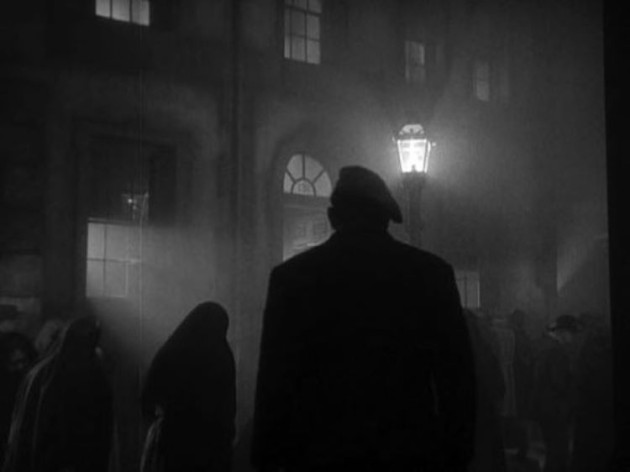
The Informer (1935, John Ford): Dublin under British occupation as an expressionist nightmare. (Photo source, Warner Home Video)
Similarly, Frankie McPhillip, the man informed on, is no longer a thug kicked out of an unnamed paramilitary organization after getting drunk and shooting a farm labourer’s union leader by mistake, but a fresh faced young man dedicated to Irish freedom whose arrival onscreen is to the tune of the patriotic “The Rising of the Moon” on the soundtrack. 16 The commandant who orders Gypo’s execution is changed from a bloodthirsty psychopath to a sincere patriot who feels sorry for Gypo, but orders him hunted down because “there’s a war on.” Frankie’s sister no longer calls the commandant an assassin, but instead reluctantly accepts Gypo’s murder as necessary and just. There is even less nuance here than in The Plough and the Stars. At least in that film Ford retained O’Casey’s socialist British corporal, but the British here are simply uniformed villains. In Ford’s adaptation of The Informer, Dublin is divided into an oppressive occupying force who gun down Frankie gangster-style as his mother and sister stand by and a subject people and their true representatives, the IRA, who are idealists fighting for liberty. Again, Ford has taken subversive material and rewritten it to conform to his romantic view of Ireland and, perhaps, the traditional reluctance of Hollywood in that period (or most other periods) to promote class conflict or social revolution.
Neil Jordan’s Progressive Alternative
The effects of the historical context and filmmaker’s sensibility are also prominent in Neil Jordan’s biopic Michael Collins. Unlike Ford, Jordan was born and educated in Ireland, and has described himself as someone who “grew up under the Ireland of Eamon de Valera and . . . wasn’t too happy about that.” 17 As a corollary of his disdain for de Valera, Jordan identifies Collins with the idea of a progressive Ireland that never happened. As he says, the “death of Collins extinguished a certain thing in Irish public life because the Free State that he helped to establish . . . came to be dominated by a very rigid authoritarian view of Irishness.” 18 There is a question of why Jordan ascribes these qualities to Collins, when it was his allies who were in government for the first decade of the Free State and their legislation on such subjects as divorce and censorship proved to be just as illiberal as de Valera would be. Nevertheless, the identification of de Valera with the failings of the society Jordan grew up in is reflected in the film’s negative portrayal of de Valera and the championing of Collins, his rival. As Brian McIlroy argues, “if a bias exists in the film, it is toward the Dublin-centered Free Staters, who [eventually] formed Fine Gael, and whose party now represents a mainly urban and educated bourgeoisie, not unlike Neil Jordan himself.” 19
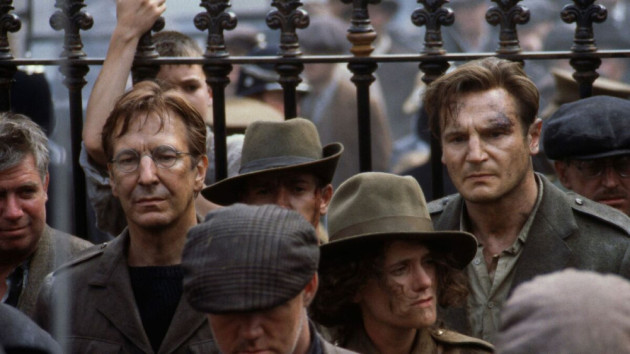
Michael Collins (1996, Neil Jordan): Alan Rickman as Eamon de Valera (left) and Liam Neeson as Michael Collins (right). (Photo source, Warner Archive Collection)
Beyond this ideological affinity with Collins, or at least Jordan’s idea of Collins, it is also worth examining the historical events occurring while the film was made. As noted, there had been virtually no films about Ireland’s revolutionary period during the Troubles in Northern Ireland. However, as Carole Zucker notes, at the time Michael Collins began production, “a cease-fire in the hostilities between the British and the republican paramilitaries had been declared. Had this not been the case, it is doubtful that a major studio would have touched such a controversial subject.” 20 Given that the film was to feature a favourable portrait of Collins, the military leader of an armed insurrection who then became one of the chief negotiators of the Anglo-Irish Treaty which ended the war with Britain, parallels with those members of the contemporary IRA and its political arm Sinn Fein who supported negotiating with the British were probably unavoidable. However, Jordan reinforced these parallels by presenting the revolutionary events in images that could be identified with events in Northern Ireland. Gary Crowdus notes that the film’s version of history features “a focus on the urban guerilla war to the virtual exclusion of any consideration of the IRA’s flying columns,” 21 which resembled most international knowledge of the Troubles, based as it was on newscast images from Belfast or Derry. Similarly, the killing of a Belfast detective by a car bomb is anachronistic for the revolutionary period, but all too familiar in 1990s Northern Ireland. As Crowdus points out, although “the IRA’s flying columns in the countryside did use grenades, land mines, and gelignite, the practice of wiring bombs to car ignitions was introduced only during the seventies by the Provisional IRA.” 22 McIlroy notes that while Jordan’s having the British use an armored car during the Croke park massacre was historically innacurate, it was “suggestive of the army and police vehicles that traversed Northern Ireland in the 1970s and 1980s” 23 and the people throwing Molotov cocktails from the windows at the Black and Tans passing below “brings this connection strongly to the surface, [as it was] an action commonplace at the beginning of the recent Troubles.” 24 These types of visual references is what leads Ronan Bennett to argue, at the time of the film’s release, that the events depicted are “clearly seen through the prism of the North of Ireland today.” 25
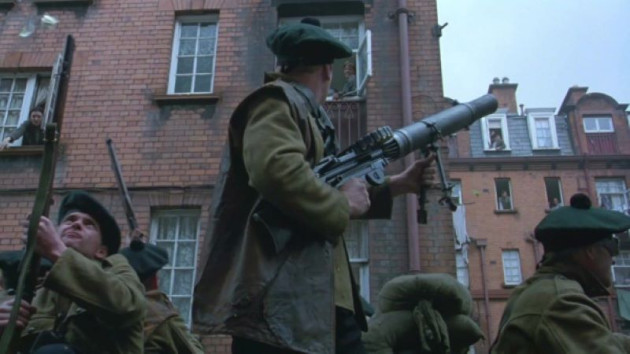
Michael Collins (1996): Molotov cocktails thrown at British troops.(Photo source, Warner Archive Collection)
Jordan’s intention was to draw a parallel between the sympathetically portrayed Collins and modern figures like then Sinn Fein leader Gerry Adams who might be willing to fill a similar role in the 1990s. One aspect of this strategy is to play down just how effective a terrorist Collins was. Although the film does show him orchestrating a number of killings, notably the murder of several British agents, the extent of the activities of him and his men goes well beyond what is shown in the film. As Suzanne Breen writes: “The ruthlessness of the IRA under Collins makes the Provos seem benevolent. In 1920-21, 525 members of the Crown forces were killed by the IRA and 1,000 were wounded. Most were not shot in face-to-face combat. They were assassinated by snipers in the streets, in their beds, at church, in lonely country lanes. In the first six months of 1921 alone, at least 707 civilians died in the war, more than were killed in the worst 15 years of the Troubles.” 26 This record actually makes his conversion to supporting a negotiated peace in the face of most of his closest allies rejecting the Treaty even more dramatic. It is possible, though, that Jordan felt it would be too much for American audiences, even though it might have made any parallel to Gerry Adams more persuasive. This parallel is certainly central to the film’s message. Bennett notes that the film’s assertion that “Collins died trying to take the gun out of Irish politics” is an “actual phrase” identified with Adams. 27 McIlroy argues that the “rhetoric of Jordan’s film is utilized in part to explain . . . that the men and women of violence, as represented by Adams and [Martin] McGuinness, will need to be accepted into negotiations” and that they will need to be supported in any splits that might follow a new treaty. 28 It is important to note that at the time Micheal Collins was made, the inclusion of the IRA into peace talks was still controversial and it was not at all clear that Adams would be as successful as he would be in carrying the mass of the IRA membership in supporting the peace process. Even so, there were splinter groups such as the Real IRA who rejected Adams’ leadership and the agreements he helped negotiate, and the worry was they would be larger and more disruptive than they turned out to be. Tom Paulin picks up on this when he notes the “film is deeply committed to the idea of negotiation and peace” and therefore it is “absolutely right to have de Valera setting up the ambush [in which Collins is killed] – which, historically is quite improper, but it imaginatively absolutely tight.” 29
If one of Jordan’s strategies is to identify Collins with contemporary peacemakers, another is to identify de Valera with potential contemporary opponents of peace. He does this by embodying the two sides of the Civil War in the figures of Collins (Liam Neeson) and de Valera (Rickman). In the scene where Collins returns from negotiating the Treaty to confront de Valera, Collins remains calm and sweetly reasonable while de Valera is shown with hair disheveled and bordering on hysteria. To Collins’ accusation that he had been sent into the talks knowing that he would not be able to achieve the stated goal of negotiating the creation of an Irish republic, de Valera can only weakly reply that this was “idle speculation.” In fact, while the pro-Treaty position is articulated clearly several times, the anti-Treaty side never is. Breen notes that the “anti-Treaty IRA are portrayed as naive, foolish boys. In reality, many of the most hardened and experienced IRA members – the Dan Breens, the Tom Barrys, the Ernie O’Malleys – opposed the Treaty.” 30 In the Dáil debate, the responses to Collins’ arguments are simply personal attacks. When Boland (Aidan Quinn), Collins’ former close friend and ally, walks out with the other anti-Treaty deputies and Collins calls him a traitor, Boland only looks back at him without speaking. De Valera is shown throughout the movie to be motivated by jealousy of Collins, as in the scene where Collins declares he “can’t run a war” without Boland, and de Valera replies “You could without me.” This reduction of political differences to personality differences is echoed by having Boland turn against Collins because Collins stole his sweetheart and having Cathal Brugha (Gerard McSorley) being envious of Collins’ fame. Treaty supporters in this film have principles, their opponents only spite. As Emer and Kevin Rockett write, “it is crystal clear who the film’s villain is.” 31 The dichotomy between Collins the heroic peacemaker and de Valera, his opponent who, in Breen’s words, is “mad, bad and dangerous to know” 32 is reinforced by the casting, with Neeson, at that time mostly known for starring as Oskar Schindler, saviour of over 1,200 Jews from the Holocaust, in Schindler’s List (1993, Steven Spielberg), while Rickman had become internationally famous playing the villainous Hans Gruber in Die Hard (1989, John McTiernan), the era’s biggest action film. As Maria Pramaggiore writes, the film’s Collins and de Valera are “reincarnations of the actors’ other roles: Neeson’s Oskar Schindler, heroic yet fun-loving; [and] just about any villain Alan Rickman has played.” 33 Jordan was aware the casting of Neeson was crucial, wryly remarking: “One of my worries was that the audience would perhaps lose sympathy for Collins because what he does is so ferocious, but halfway through I realized Liam could chop up his grandmother and he’d still be a sympathetic guy.” 34
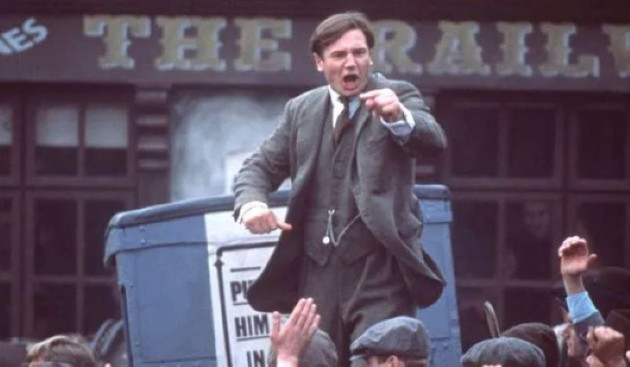
Michael Collins (1996): Liam Neeson strikes a heroic pose.(Photo source, Warner Archive Collection)
In contrast to Neeson’s charming Collins, Rickman’s chilly de Valera is almost without any redeeming features. As the Rocketts point out, he “is represented not just as a jealous lover who breaks up the Collins/Boland couple, but in the escape from Lincoln Jail he is characterized as a prostitute.” 35 In the cab after de Valera has escaped from the jail by disguising himself in woman’s clothes and masquerading as a streetwalker, Collins even says “Some died for Ireland. But Dev, he whored for Ireland.” The most controversial aspect of this dark portrait of de Valera is the allegation he colluded in Collins’ assassination. As Paulin’s comment suggests, there is a dramatic logic in linking de Valera to the killing. If the film’s thesis is that terrorists risk their lives when they move toward peace, it makes sense to have the film’s embodiment of opposition to peace be responsible for murdering the peacemaker. Crowdus also suggests that this was a result of “Jordan’s need, as a dramatist, to somehow reunite the two characters in that final scene.” 36 Still, it begs the question of whether there shouldn’t be some responsibility to the historical record, particularly when it is used to shape a political argument intended to apply to a contemporary issue. Jordan attempts to evade this question by claiming he is not saying de Valera was responsible, 37 but the very least that can be said is that the film strongly implies it. McIlroy certainly makes that interpretation, and then claims this was “not a new accusation.” 38 Unfortunately, his footnoted source for this statement is that Jordan claims to have read every biography of Collins (without saying which, if any, included this accusation) and then saying that Tim Pat Coogan once claimed he was told this. If so, it might have been helpful to say whether Coogan had included this in any of his books. In fact, Coogan’s biography of Collins, which Jordan stated was his chief source, explicitly states that de Valera strongly opposed any suggestion of trying to kill Collins in the belief that he would be the best person to negotiate with if things continued to go badly for Treaty opponents. As Chandler writes, “the conspiracy theory served Jordan’s purpose better than established historical fact.” 39 Similarly, Crowdus claims “some historians” have stated de Valera was experiencing a nervous breakdown at the time, but does not say which historians. 40 In the end, the suspect history and dramatic stacking of the deck cannot help weakening both the film’s dramatic effectiveness and its political intent.
Ken Loach’s Anti-Colonial Struggle
A different kind of deck stacking can be found in Ken Loach’s The Wind That Shakes the Barley. Where Michael Collins was “great man” history in the style of the Pearse and Connolly scenes in Ford’s adaptation of The Plough and the Stars, Loach’s film is resolutely a tale from the sidestage of history, and centered on the common man. This was not a great departure for Loach, whose films typically deal with the lives of the English and Scottish working classes from a straightforwardly socialist point of view and had previously made period films that examined historical events from that perspective. This film’s narrative follows the experiences of members of an IRA flying column loosely based on Tom Barry’s 3rd (West) Cork Brigade, and includes a reenactment of the famous Kilmichael ambush. The focus is on two brothers, Damian (Cillian Murphy) and Teddy (Padraic Delaney), who fight along side each other in the Anglo-Irish War and then on opposite sides of the Civil War. The depiction of the revolutionary period differs from the films already discussed in two ways, by dramatizing the involvement of the trade union movement in the fight for independence and by showing the conflicts in images that recall insurgent struggles against colonial powers in Africa, Asia, and Latin America. The train driver and strong trade unionist Dan (Liam Cunningham) is a figure completely absent from the other films. While Connolly could have represented a similar figure in The Plough and the Stars, at no time during that film is his role as a labour leader or his involvement in the trade union movement ever mentioned. In contrast, Dan is central to Loach’s story, as it his successful refusal to transport British soldiers the act that convinces Damian that resistance to the British is possible.
Loach’s goal was to make “a classic story of an imperial power trying to safeguard its interests while making a tactical retreat.” 41 The film’s historical consultant, Donal Ó Drisceoil, makes the point that while the film is set in Ireland, “the location is never stated explicitly. Thus the historical canvas has sufficient space for the exploration of the issues at stake, freed of the restrictions of biography and geography.” 42 Where Jordan was looking for parallels to the contemporary conflict in Northern Ireland, The Wind That Shakes the Barley was made in post-Good Friday Agreement Ireland and Loach stated firmly in an interview given at the time of his film’s release that while he was prepared to discuss the Troubles in Northern Ireland, references to the modern IRA are “not in the film.” 43 Instead, Loach and his frequent screenwriter Paul Laverty wanted to focus on the issue of colonialism and, in particular, its relationship to the then ongoing Iraq War. As Laverty argues concerning Iraq: “The historical detail may have changed but the psychology of occupation is still very similar . . . if we knew what we had really done in Ireland, it would be much harder to persuade the population that we are on a civilizing mission abroad.” 44 This focus emphasizes Ireland’s colonial status, but also served to cast the Anglo-Irish War as an incipient social revolution which is snuffed out by a domestic bourgeoisie. This is effectively dramatized in a scene in which the ruling of a revolutionary court is nullified at the insistence of one of the movement’s financial backers. At the center of this scene is guerilla leader Teddy, whose support for the suppression of the revolutionary court is the second signal of his eventual betrayal of his brother and revolutionary comrades and transformation into Free State stooge, the first being his appreciation of the den of a pro-British landlord his group is abducting. As he remarks on its beauty, the others maintain a stodgy proletarian indifference. These scenes are intended to illustrate the “class dynamics of the impending split in the independence movement” 45 and the film strongly suggests this was the underlying cause of the Civil War. Like the alleged liberal state that Jordan believed died with Michael Collins, this is difficult to square with the deep social conservatism of the Irish during this period, as well as the fact that the at least nominal leader of the anti-Treaty forces was Eamon de Valera, who nobody has ever credibly claimed was an advocate of any kind of socialist revolution. While giving the pro-Treaty argument only marginally more weight than Jordan gave the anti-Treaty forces, it remains a stubbornly unconvincing thesis. Even Ó Drisceoil recognizes this, conceding that in that period “the socialist message remained largely verbal and unlistened to.” 46 He goes on to argue that the film was intended as a story of the Irish revolution, not the story of the Irish revolution 47 , but this ignores completely how cinema works to universalize specific situations. If it is an isolated and atypical story, how can it be used to comment about colonialism in general or the Irish revolution in particular?

The Wind That Shakes the Barley (2006) The irish revolution as agrarian insurgency and part of global struggle against imperialism. A rebel falls in echo of image of famous image from Spanish Civil War. (Photo source, IFC Films)
A notable difference between The Wind That Shakes the Barley and other Loach films is the portrayal of the British characters. Loach has written that he did not make an anti-British film, and that he believes people should “see their loyalties horizontally across national boundaries . . . People have much more in common with people in the same social position in other countries than with those at the top of their own society.” 48 Earlier films Loach made outside of Britain, Hidden Agenda (1990), inspired by the Stalker Affair in Northern Ireland, Land and Freedom (1995), set during the Spanish Civil War of the 1930s, and Carla’s Song (1996), which takes place in Nicaragua at the time of the Sandanista government’s struggle with the counterrevolutionary Contras in the 1980s, reflected this belief. All featured sympathetic British protagonists who travel to foreign lands and make common cause with the ordinary people they find there. However, in The Wind That Shakes the Barley, all the sympathetic characters are Irish, and the only British on view are the savagely vicious Black and Tans, irregular troops recruited in Britain to suppress the revolt, who are described as “mercenaries sent over here to make us crawl.” Ó Drisceoil makes no apologies for this, writing: “It is no accident that the Tans are represented as one-dimensional and brutal – to their victims that is how they appeared: they were racist, vicious and ignorant.” 49 Or, as Loach succinctly puts it in a marvelously entertaining interview where he calls British critics of the film “whores of imperialism,” the issue of fairness would not arise “if we were making a film about the French Resistance.” 50 Class solidarity does not extend to Nazis, even if they are British and working class.
Luke Gibbons writes that “the main task of evaluating a historical film is not the pedestrian one of identifying ‘inaccuracies,’ but the more difficult one of determining the point of these inaccuracies.” 51 Therefore, to a certain extent, much of the extensive criticism all these films have received for their historical inaccuracies is less important, raising a less interesting question, than why the films are inaccurate and whether these inaccuracies are effective in supporting or undermining what the arguments the filmmakers are trying to make. That is the question this essay has been trying to address.
BIBLIOGRAPHY
Archibald, David. “Correcting Historical Lies: An Interview with Ken Loach and Paul Laverty.” Cineaste. 32.2 (2007): 26-30.
Breen, Suzanne. Who Is the Real Michael Collins?” Fortnight. 356, Dec 1996, 7.
Canavan, Tony. “The Informer.” Books Ireland. 374 (July/August 2017): 28-9.
Chandler, James. “Cinema, History, and the Politics of Style: Michael Collins and The Wind That Shakes the Barley.” Field Day Review. 7 (2011): 102-121.
Clarke, Amanda. “Keepin’ a Home Together”: Performing Domestic Security in Sean O’Casey’s “The Plough and the Stars.” The Canadian Journal of Irish Studies. 38. 1-2 (2014): 208-227.
Crowdus, Gary. “The Screenwriting of Irish History: Neil Jordan’s Michael Collins.” Cineaste. 22.4 (1997): 14-19.
Dodd, Philip. “Ghosts from a Civil War.” Sight & Sound. 6.12 (1996): 30-32.
Eyman, Scott. Print the Legend: The Life and Times of John Ford. Baltimore, MD: John Hopkins University Press, 1999.
Gallagher, Tag. John Ford: The Man and His Films. Berkeley, CA: University of California Press, 1986.
Gibbons, Luke. “Framing History: Neil Jordan’s Michael Collins.” History Ireland. 5.1 (1997): 47-51.
Gibney, John. “Televising the Rising.” History Ireland. 24.2 (March/April, 2016): 50-51.
Gilligan, Paula. “A Monotonous Hell.” Early Popular Visual Culture. 5.3 (2007): 301-316.
Hopper, Keith. “‘Cat-Calls from the Cheap Seats”: The Third Meaning of Neil Jordan’s Michael Collins.” The Irish Review (Cork). 21 (Autumn-Winter, 1997): 1-28.
“Ireland’s First Sound Film.” RTE Archives. https://www.rte.ie/archives/2016/0118/761034-the-making-of-the-dawn/
Linehan, Hugh. “Restored Version of First Irish Sound Film ‘The Dawn’ To Be Screened.” Irish Times. Dec 8, 2016. https://www.irishtimes.com/culture/film/restored-version-of-first-irish-sound-film-the-dawn-to-be-screened-1.2898353
Loach, Ken. “Director’s Note.” The Wind That Shakes the Barley: A Screenplay. Ed. Paul Laverty. Anfield, Ireland: Galley Head Press, 2006, 7-9.
McBride, Joseph. Searching for John Ford. New York, NY: St. Martin’s Griffin, 2001.
McIlroy, Brian. “History Without Borders: Neil Jordan’s Michael Collins.” Irish Cinema: From The Quiet Man to Dancing at Lughnasa. Ed. James MacKillop. Syracuse, NY: Syracuse University Press, 1999, 22-28.
McSwiney, Seamas. “Trying to Take the Gun Out of Irish Politics: An Interview with Neil Jordan.” Cineaste. 22.4 (1997): 20-24.
Moran, Daniel. “Printing the Legend of John Ford’s The Informer.” New Hibernia Review/Iris Éirennach Nua. 15.4 (Winter 2011): 127-143.
Morgan, Eileen. “Ireland’s Lost Action Hero: Michael Collins, a Secret History of Irish Masculinity.” New Hibernia Review/Iris Éireannach Nua. 2.1 (Spring, 1998): 26-42.
Ó Drisceoil, Donal. “Framing the Irish Revolution: Ken Loach’s The Wind That Shakes the Barley.” Radical History Review. 194 (2009): 5-15.
Pramaggiore, Maria. “Bullet-Riddled/Star- Studded History: Neil Jordan’s Michael Collins.” Jouvert: A Journal of Postcolonial Studies. 1 (1997): https://legacy.chass.ncsu.edu/jouvert/v1i1/PRAMAG.HTM
Rockett, Emer and Kevin Rockett. Neil Jordan: Exploring Boundaries. Dublin, Ireland: Liffey Press, 2003.
“Saoirse?” Irish Film Institute. https://ifi.ie/film/saoirse/
Slayton, Robert A. “When a Catholic Terrified the Heartland. New York Times. (December 10, 2011): https://archive.nytimes.com/campaignstops.blogs.nytimes.com/2011/12/10/when-a-catholic-terrified-the-heartland/?mcubz=0
Smith, Claire. “Neil Jordan’s Michael Collins (1996): (Re)Imagining the ’Post’-Conflict Nation on the Global Stage.” QPOL (Queen’s Policy Engagement). (August 22, 2022): http://qpol.qub.ac.uk/neil-jordans-michael-collins-1996-reimagining-the-post-conflict-nation-on-the-global-stage/
Zucker, Carole. The Cinema of Neil Jordan: Dark Carnival. London, UK: Wallflower Press, 2008.
Notes
- James Chandler. “Cinema, History, and the Politics of Style: Michael Collins and The Wind That Shakes the Barley.” Field Day Review. Vol. 7 (2011): 104. ↩
- Hugh Linehan. “Restored Version of First Irish Sound Film ‘The Dawn’ To Be Screened.” Irish Times. Dec 8, 2016; RTE Archives. ↩
- This suggestion is supported by the fact that, despite its classic status, O’Casey’s play has been adapted for television in Britain, Canada, the United States, and Sweden, but its first (and only) production for Irish television was not until 1980, and that was a co-production between RTE, Ireland’s national broadcaster, and BBC Northern Ireland. The Hitchcock version is the only adaptation to have been released in cinemas. ↩
- “Saoirse?” Irish Film Institute. https://ifi.ie/film/saoirse/ ↩
- The film is the second most popular film in Irish box office history, second only to Titanic (1997, James Cameron). It has been estimated that it was seen by 1.5 million people in Ireland, roughly 40% of the population, during its initial theatrical release. Claire Smith. “Neil Jordan’s Michael Collins (1996): (Re)Imagining the ’Post’-Conflict Nation on the Global Stage.” QPOL (Queen’s Policy Engagement). (August 22, 2022): http://qpol.qub.ac.uk/neil-jordans-michael-collins-1996-reimagining-the-post-conflict-nation-on-the-global-stage/. ↩
- There was a television film made for RTE, Ballyseedy (1997, Frank Hand), which dramatized a notorious incident from the Civil War where Irish government forces killed nine IRA members by forcing them to walk through a minefield, but unlike The Wind That Shakes the Barley, it was never released in cinemas. ↩
- Amanda Clarke. “Keepin’ a Home Together”: Performing Domestic Security in Sean O’Casey’s “The Plough and the Stars.” The Canadian Journal of Irish Studies. 38. 1-2 (2014): 208-227. Members of the audience swarmed the stage, assaulted the performers, smashed the set, and set fire to the curtains. ↩
- Paula Gilligan. “A Monotonous Hell.” Early Popular Visual Culture. 5.3 (2007): 305. ↩
- Joseph McBride. Searching for John Ford. New York, NY: St. Martin’s Griffin, 2001, 243. ↩
- Leader of the Irish Citizen Army, a socialist, working class-based militia allied to Pearse’s Irish Volunteers. The flag of the Citizen Army featured the plough and the stars that the title of O’Casey’s play refers to. Like Pearse and the other leaders of the Rising, Connolly was executed following its suppression. ↩
- Robert A. Slayton. “When a Catholic Terrified the Heartland.” New York Times. (December 10, 2011): https://archive.nytimes.com/campaignstops.blogs.nytimes.com/2011/12/10/when-a-catholic-terrified-the-heartland/?mcubz=0 ↩
- This was also, of course, the era in which James Cagney played Irish American gangsters in a series of films, but this was usually balanced by having him die in a hail of bullets while an Irish American priest (usually played by Pat O’Brien) mourned his passing. ↩
- Scott Eyman. Print the Legend: The Life and Times of John Ford. Baltimore, MD: John Hopkins University Press, 1999, 176. ↩
- Ibid, 176. ↩
- Tag Gallagher. John Ford: The Man and His Films. Berkeley, CA: University of California Press, 1986, 123. ↩
- The film makes it clear that the unnamed organization is the IRA, and it is often assumed it is the same for the novel. However, the group referred to only as “the organization” was actually supposed to be a communist splinter not affiliated with the IRA, but a branch of an international network. Tony Canavan. “The Informer.” Books Ireland, No. 374 (July/August 2017): 28. ↩
- Seamas McSwiney. “Trying to Take the Gun Out of Irish Politics: An Interview with Neil Jordan.” Cineaste. 22.4 (1997): 21. De Valera was the most senior of the Rising leaders not to be executed, possibly because he was born in the United States. He was the President of Ireland during the revolutionary period and the nominal leader of the anti-Treaty forces during the Civil War. After a decade in opposition, during which he founded the Fianna Fáil political party, he returned to power, heading the government 1932-48, 1951-54, and 1957-59, after which he served in the largely ceremonial role of the country’s President 1959 -73. ↩
- Op cit, 21. ↩
- Brian McIlroy. “History Without Borders: Neil Jordan’s Michael Collins.” Irish Cinema: From The Quiet Man to Dancing at Lughnasa. Ed. James MacKillop. Syracuse, NY: Syracuse University Press, 1999, 28. ↩
- Carole Zucker. The Cinema of Neil Jordan: Dark Carnival. London, UK: Wallflower Press, 2008, 9. ↩
- Gary Crowdus. “The Screenwriting of Irish History: Neil Jordan’s Michael Collins.” Cineaste. 22.4 (1997): 16. ↩
- Ibid, 19. ↩
- McIlroy, op cit, 26. ↩
- Ibid, 27. ↩
- Philip Dodd. “Ghosts from a Civil War.” Sight & Sound. 6.12 (1996): 30. ↩
- Suzanne Breen. Who Is the Real Michael Collins?” Fortnight. 356, Dec 1996, 7. ↩
- Ibid, 30. ↩
- McIlroy, op cit, 26. ↩
- Dodd, op cit, 30. ↩
- Breen, op cit, 7. ↩
- Emer Rockett and Kevin Rockett. Neil Jordan: Exploring Boundaries. Dublin, Ireland: Liffey Press, 2003, 169. ↩
- Breen, op cit, 7. ↩
- Maria Pramaggiore. “Bullet-Riddled/Star- Studded History: Neil Jordan’s Michael Collins.” Jouvert: A Journal of Postcolonial Studies. 1 (1997): https://legacy.chass.ncsu.edu/jouvert/v1i1/PRAMAG.HTM ↩
- Eileen Morgan. “Ireland’s Lost Action Hero: Michael Collins, a Secret History of Irish Masculinity.” New Hibernia Review/Iris Éireannach Nua. 2.1 (Spring, 1998): 35. ↩
- Ibid, 169. ↩
- Crowdus, op cit, 17. ↩
- Ibid, 17. ↩
- McIlroy, op cit, 25. ↩
- Chandler, op cit, 107. ↩
- Crowdus, op cit, 17. ↩
- David Archibald. “Correcting Historical Lies: An Interview with Ken Loach and Paul Laverty.” Cineaste. 32.2 (2007): 26. ↩
- Donal Ó Drisceoil. “Framing the Irish Revolution: Ken Loach’s The Wind That Shakes the Barley.” Radical History Review. 194 (2009): 9. ↩
- Archibald, op cit, 30. ↩
- Ibid, 30. ↩
- Ó Drisceoil, op cit, 8. ↩
- Ibid, 12. ↩
- Ibid, 12. ↩
- Ken Loach. “Director’s Note.” The Wind That Shakes the Barley: A Screenplay. Ed. Paul Laverty. Anfield, Ireland: Galley Head Press, 2006, 7. ↩
- Ó Drisceoil, op cit, 13. ↩
- Archibald, op cit, 28. ↩
- Luke Gibbons. “Framing History: Neil Jordan’s Michael Collins.” History Ireland. 5.1 (1997): 50. ↩



